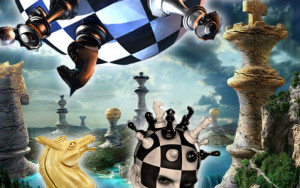Boy I wish I were a GM. I’d be famous, I’d have hot babes following me around and get *paid* to play chess…! Can you visualize that? O, I can!
Have you ever had a chess dream? Chess is *not* just calculation – it’s dreaming in patterns and trends while you’re awake. And to get better we need to exercise that muscle!
ALL RIGHT, MAGGOTS, DROP AND GIVE ME TWENTY! In your mind, please, get up off the floor.
The rules for this first exercise are ‘Start by moving forward, then always move in the direction the knight was going when it stopped. Always turn right. Move the most squares first if you can.’ A standard knight’s first move will be a1 to a3, turn right and go to b3. The knight was moving from a3 to b3 when it stopped, so it has to move b3-c3-d3 first, then turn right and go to d2. Now to continue in that direction, you run into the edge and can’t make a long move first, so do the short move to d1, then turn right and go to b1.
WITHOUT moving a piece, visualize this in your head. Try a normal knight move first, then try a knight move with THREE squares first instead of two. What happens?
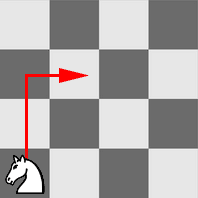
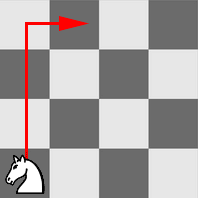
In the exercise with the longer move, what is the first first-row square the knight ends on?
Ha! Gotcha. What happens if the 3-square knight starts on a2? Does your head hurt yet? Is there a knight move that follows these rules and touches every square? The answer is ‘no’ – so why not?
And (killer of killers) we are so far only dealing with *one* piece! Could you play a blindfold game? I won a blindfold exhibition when I was in high school – and won seven more over the board (a simul) at the same time against the local chess club!
===> I am not so sure I could make it through a whole game now – so I can tell my brain-power has changed. Our powers of previsualization are critical for so many things, and ‘pure chess calculation’ is a basic thing – but not the *only* thing!
GMs do not simply calculate long lines of tactics!
We *can* learn more than one way to visualize and we *can* improve the process at any age! (It is hard to do, but we *can* do it!) I will give an example:
As I learned photography as a fine art and profession in the days of film, I trained to visualize the textures, densities and feelings of a fine print before I took the picture. The system was complex but still relied on my raw ability to see pictures in my head that did not yet exist.
Try staring at something here in the room. Now imagine it in black and white. Can you visualize pasting a picture of a flower somewhere in your image?
Maybe not so easy, but what if you practiced? A lot? What if you used practice tools?
You *can* train yourself to rely on more intuition by imagining your games not in terms of concrete variations, but in what kinds of future positions you can aim for. STATIC PAWNS + MOBILE PAWNS + TARGET PAWNS + SEMI-OPEN FILES + OUTPOSTS + PIECE COORDINATION + etc etc.
Next exercise: Here is a *fuzzy* position! *NOW* talk to yourself about strategy, outposts, pawn structures, targets and trends!
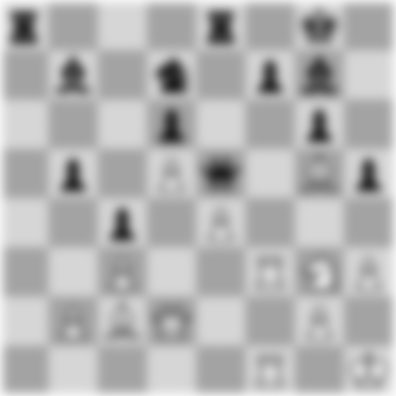
Can you start to see things in patterns now?
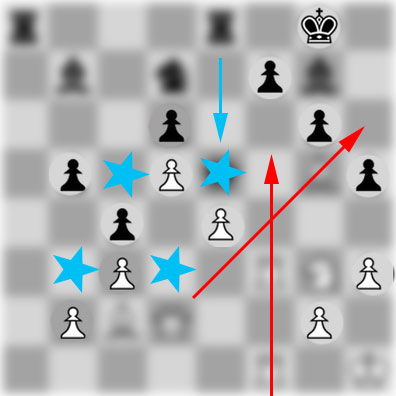
Here’s an interesting graphic from Seth Kadish: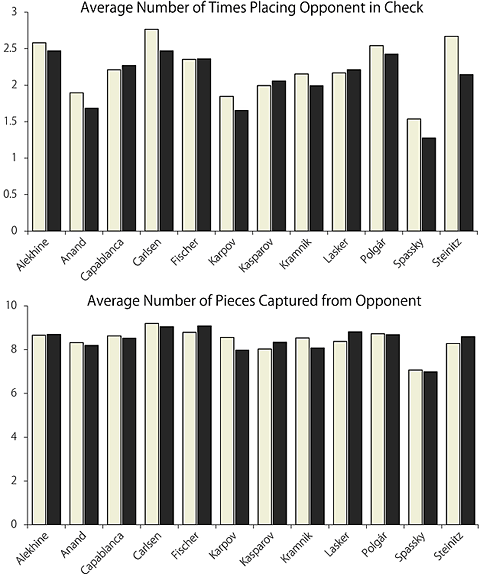
What do you get from this? Gimme a dollar and I’ll tell you what it means.

OK – I’ll give it up for free. I think it means Spassky did not need to capture pieces or give checks in order to win because he could visualize an advantage so well that he won without captures and checks. What he saw in his head gave him winning tactics, tempo gains, mates, binds, outposts, targets, zugzwangs, attacks – all the threats needed – just by maneuvering in his head! How could he do that? I believe he was that much better at visualizing things! He saw the position, I think, as a whole gestalt, not just ‘some tactic over here and some strategy over there’.
Here is the game between Tal and Spassky that gave us our fuzzy position. You can come back to it online and see the game (which is *amazing*!) on your own. BTW – in this one Spassky *loses* rather spectacularly to the dreams of Tal!
——————————————
Look at this position… ‘Rules’ have been broken by black, yes? He has two bishops in a fairly closed position and doubled pawns, both of which are supposed to be bad. White even has a passed pawn! What do you think of the position?
This is from my game with Bill – and I am playing black, with white to move here. I *aimed* for this kind of game! Why? Well, before this position, I deliberately exchanged away my remaining knight and allowed the passed pawn. (By doing so I completely stopped white’s coming queen side attack, which was brewing up.) But could I follow this up to any advantage? What did I imagine and visualize?
I did see a picture in my head like this as well as a picture like the next one – I saw things unfolding. I also did not see a good way for white to prevent the development of what I saw! I rationally thought like this: White’ rooks are out of the game, the passed pawn is worthless until a very late ending, e3 is weak and the e4 pawn is a target, though a direct attack on it looks useless for now. Black owns more of the center and the d-file is all mine. The knights are stranded in defensive roles just like my bishops.
But it almost looks like no one can move! White can defend e3 with Ng2 and one of his rooks can retreat and swing around to the king side, right?
So which side can become aggressive sooner and which will have more effect?
My money is on black. The f-pawn will become a battering ram in a mass with the two e pawns against this weak center / king side, ripping it to shreds and opening the game – in *my favor*. The h-file will work for me before white can reorganize, even allowing black to play g5 perhaps. Looking not far into the future we can consider that the white king might not be so safe!
Bill miscalculated some tactics and we did not get to see – but I think we’d have gotten something like this – a very different looking situation!
This is from a line of analysis, but the kinds of things that are happening now are much more dangerous for white. Taking the f4 pawn would be awful, but leaving it there is bad, too! I doubt white could stop the f7-f5 advance… Black’s bishops still *look* closed in but somehow they are not longer cramped-looking. Now they exert menacing pressure!
How do you visualize something like this without calculating exact moves? Even without ‘seeing’ this advanced picture in your head, you still *can* have a conversation with yourself about the mobility of the pawns, turning the other guy’s pawns into targets, the mobility of your resources… Remember how we talked about blitzkrieg, ‘schwerpunkt’ and attack? Building a position is the same thing, only perhaps slower. *Visualizing* that process is a matter of patterns not just that you recognize, but patterns in motion that can morph from one to another. Think of it as looking for trends instead of analyzing tactics.
Sometimes (especially in attack and defense) you simply have to see the tactics, it’s true. (Don’t *ignore* the tactics! Our dream time has to be added on top of making sure the basic tactics are OK.) Visualizing in the case of tactics is not just raw analysis and here I want to point you toward the idea of truly creating something. You simply have to dream it up! You must look for the unexpected!
Here is another club game of my own, against a class B: From a few moves before this I had already concocted an interesting idea… one I did not think my opponent would see!
Did you find Nf6+? Do you think the other guy wouldn’t see such a direct threat? Can you see *past* that and look for unexpected moves?
OK, the tactics work if black takes the knight; at best black’s pawns will be badly broken and at worst – well – it could be pretty ugly. But what will you do against Kh8, when black has left your poor knight stranded and triple attacked? My opponent told me that he had seen Nf6+ and wasn’t afraid of it at all because of Kh8. He saw no danger and felt safe.
But if you have looked for a way to give away one piece, then you should look for how to give away another. 1. Nf6+ Kh8 2. Ng5!
Black can resign. Guarding f7 with the d8 rook loses the knight on d7 with further embarrassment to follow. Taking the f6 knight gets hammered the same ways as before and the horrible h:g5 gets mated immediately with Qh5.
PS – Max asked about Kf8 instead of Kh8. Ng5! still works because of Qh5 and a beautiful king hunt ensues! But I did not analyze it deeply because I *knew* my opponent would feel safe with Kh8! It was almost literally like reading his mind!
So I will leave you with a play-it-now assignment – let’s pair off. I want you to try and see your games in terms of trends, strategies and goals. Try to see general patterns of movement that could unfold.
Count your moves until you are at move 10. Write down two things you see that are good for you, two for the other guy. Make a general prediction about the kinds of things that might happen. Stop at move 20 and think about your notes. Did your predictions come true? Talk about this stuff, then either start over or try it again, this time just 5 more moves (move 25). Deliberately try *not* to analyze variations. Who is attacking? Who has good targets? Who has the best open and semi-open lines? Piece outposts? Divide the board into areas 4×4 and talk about them in the same way. Are you seeing trends?
To *really* work on visualizing, try to do this exercise (same stopping places etc) – but for your opponent! Give him a report on what you see *for him*!

